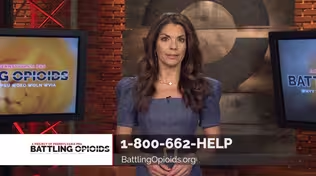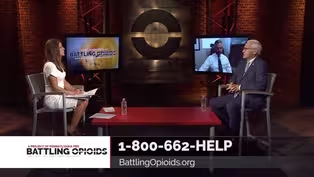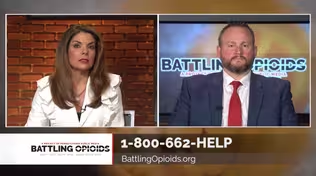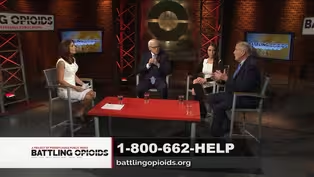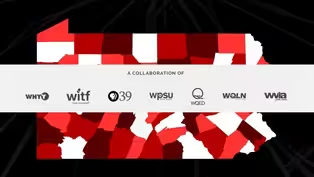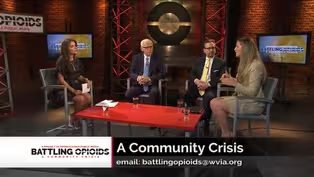WVIA Special Presentations
Battling Opioids A Project of Pennsylvania PBS, Part 7
Season 2021 Episode 2 | 54m 59sVideo has Closed Captions
Explore how the underserved and people in recovery are affected by the pandemic
Part Seven of the Pennsylvania PBS television series Battling Opioids focuses on how the underserved and people in recovery are affected by the pandemic. How Covid-19 is impacting the opioid crisis,and how providers are changing treatments.
Problems playing video? | Closed Captioning Feedback
Problems playing video? | Closed Captioning Feedback
WVIA Special Presentations is a local public television program presented by WVIA
WVIA Special Presentations
Battling Opioids A Project of Pennsylvania PBS, Part 7
Season 2021 Episode 2 | 54m 59sVideo has Closed Captions
Part Seven of the Pennsylvania PBS television series Battling Opioids focuses on how the underserved and people in recovery are affected by the pandemic. How Covid-19 is impacting the opioid crisis,and how providers are changing treatments.
Problems playing video? | Closed Captioning Feedback
How to Watch WVIA Special Presentations
WVIA Special Presentations is available to stream on pbs.org and the free PBS App, available on iPhone, Apple TV, Android TV, Android smartphones, Amazon Fire TV, Amazon Fire Tablet, Roku, Samsung Smart TV, and Vizio.
Providing Support for PBS.org
Learn Moreabout PBS online sponsorshipMore from This Collection
Battling Opioids A Project of Pennsylvania PBS, Part 8
Video has Closed Captions
Stories about veterans, the underserved, and people in recovery affected by the pandemic (55m)
Battling Opioids: A Project of PA Public Media Part 6
Video has Closed Captions
Part 6 focuses on the impact Covid-19 is having on the opioid epidemic (55m)
Battling Opioids: A Project of PA Public Media Part 5
Video has Closed Captions
Looking Back to Look Ahead in Recovery (55m)
Battling Opioids: A Project of PA Public Media Part 4
Video has Closed Captions
Exploring the future of treatment in the ongoing battle against opioid addiction. (55m)
Battling Opioids: A Project of PA Public Media Revisited
Video has Closed Captions
Featuring a new panel discussion (1h 26m)
Battling Opioids: A Project of Pennsylvania Public Media
Video has Closed Captions
Pennsylvania's Public Television Stations (PPT), are confronting this crisis head-on. (1h 26m)
Battling Opioids: A Community Crisis
Video has Closed Captions
State & local leaders discuss current strategies to fight the opioid crisis in our region (55m 59s)
Providing Support for PBS.org
Learn Moreabout PBS online sponsorship- [Announcer] Live from your public media studios, WVIA presents Keystone Edition Health, a public affairs program that goes beyond the headlines to address issues in northeastern and central Pennsylvania.
This is Keystone Edition Health.
And now moderator, Tonyehn Verkitus.
- Good evening and welcome to Keystone Edition Health.
I'm Tonyehn Verkitus.
Thank you for joining us.
It's a new year and a new chance for us to evaluate and improve upon our health.
While we may have set individual goals, there's plenty that our communities and leaders can do to improve wellness opportunities for the public.
If you have a question, call +1 800-326-9842, email at keystone@wvia.org or social media #Keystonehealth.
But first, Keystone Edition's Paul Lazar will tell us about initiatives already working to transform public health in Pennsylvania.
- [Paul] The new year has arrived.
While 2020 presented an array of challenges to our health, 2021 can be a chance to rebuild and set goals to live healthier.
While many of us likely set resolutions to exercise, eat in a healthy way or lose weight.
We can't get healthier on our own.
Our communities can set goals to improve public health through their own initiatives to make healthier living possible.
How can cities and northeastern and central Pennsylvania improve the health of their residents.
An initiative known as Blue Zones beliefs that we can apply the methods that have worked in areas across the globe, where people live their longest and healthiest and communities are working to apply the Blue Zone model to give their residents access to a healthy lifestyle.
Locally, Geisinger Springboard Health project beliefs that targeting preventive care, behavioral health and economic growth can improve community health.
Stay tuned for more on these programs and how they can improve our area in this new year of 2021.
I'm Paul Lazar for Keystone Edition Health.
- Joining us in studio is Gus Fahey, President of Valley In Motion which is working to apply the Blue Zone concept to the Lackawanna Valley.
Brian Ebersole has also joined us in the studio tonight.
He is a senior director of Geisinger's Springboard Health project.
And joining us over Zoom is Melissa Lyon.
Erie's Director of Public Health.
If you have questions, please call +1 800-326-9842, email at keystone@wvia.org or on social #Keystonehealth.
Happy new year, everyone.
Thank you for joining us.
I'm really excited about our conversation.
I've been hearing about Blue Zones for years.
I do understand that at times it is very hard to have motivation that comes internally.
So you all can share with us how the community can provide more wellbeing and happiness to the community.
Gus, can you tell us a little bit about Blue Zones?
- Sure.
Tonyehn, thanks for having me on the program.
Blue Zones are areas of the world where people have exceptional health and happiness and they're really connected to their community.
They have a strong sense of purpose and they move in their community naturally.
Their communities are set up to have maximum health, and it's not just because of advanced health systems, it's designed so that people walk, so that people eat healthy foods.
And the easy choice, the healthy choice is actually the easy choice.
We wanna design our communities so they're built for health.
- Thank you.
Melissa, I know that you've been working on a Blue Zone project for about four years.
Can you tell us a little bit about how you decided to adopt this project and if there were any obstacles along the way?
- Yeah, so thank you so much for having me this evening.
And you're correct, it took about four years to really get the project, I believe we've been working on it for four years.
It's been in place going on its second year.
We decided to pursue a Blue Zones project because county health departments are expected to have community health needs assessments.
And when you evaluate your needs assessment you then have to create what's called a community health improvement plan.
And frankly, many community health improvement plans are done from a grassroots level and are really focused on outputs and not outcomes.
And so the Blue Zones project is really an evidence-based strategy, very comprehensive.
It focuses on outcomes, meaning are you really making a difference in individual's BMI?
Are people actually having less cases of diabetes in your community?
Are you seeing lower blood sugar and so on and so forth?
And many programs just measure outputs such as how many people participated in a walking program.
So for us, it just seems like a really great evidence-based strategy proven throughout the country in many different locations.
And we would not be putting our efforts into outputs but actually measuring outcomes.
And I suspect that throughout the program I'll talk more to you about the data and the accountability.
So I hope that's a good answer for what you were looking for at the moment.
Thank you.
- Brian, I've actually known you for a few years.
We initially met because of Scranton Transformers which was meant to be something similar.
Before we talk about that.
Can you tell us a little bit about Springboard's commitment to the well-being of the community?
- Absolutely.
Thank you so much for the opportunity to be part of the discussion as we think about that overall health and the broadest definition of health that we can look for in the communities in which we live.
And so Springboard is powered by Geisinger.
It's really this opportunity for incubating ideas to look at the improvement of the health of our community.
And so we pulled lots of different levers and look at lots of different components.
So whether that's healthy food access, or maybe it's access to transportation or even addressing, now in the days of the pandemic, social isolation among older adults.
There's lots of activities that plug into it.
And it's really about making health easier for the individuals.
As Gus mentioned, how do you make the right decision or the right choice the easy choice.
And so something like Springboard, which is now part of everything that we do at Geisinger has really opened up the door to be able to be part of a conversation like Blue Zones and considering what does that look like and what does it mean for our community?
And so we're excited to be part of that discussion and excited to come into a sponsorship of this information gathering phase of the project.
- Gus, at its core, Blue Zone is really about happiness and wellbeing.
Correct?
- Right.
- So what types of actions can you take within the community that will help provide this for its members?
- Right, well, it really comes down to people, places, and policies.
So people can join in different different groups that have healthy lifestyles.
So healthy cooking or walking groups or biking groups, or volunteering.
Things that give people a strong sense of purpose and connection with others.
The places that they go to, so workplaces or schools or grocery stores all these things where we learn good habits and have them reinforced.
There's all these places that could be making a difference in making sure that the right choice is easy choice.
And then there's policies.
So not only healthy policies for our municipalities but infrastructure, you know we spent all this money taking or building roads that split us apart and split from where we live, to where we shop, to where we work, to where we go to school in separate places.
We really, really need to rethink the way that we organize ourselves so that we can walk to work or we can bike to work or we can walk to school and make sure that our communities are built in a way that they were originally designed.
So that's something that's really interesting to me.
Our communities in northeastern and central Pennsylvania were usually built around a central core and everybody lived where they could get to their place of worship or they could get to local shopping.
All those things were in a limited life radius.
And in some ways, we're just trying to rediscover what worked in the past and apply it to today's world.
- So in these Blue Zones, their environment basically enhances the wellbeing, right?
- That's right.
- So if there were things put in place that forced us to walk, I hate to say force, then maybe we'd be more likely to do it because it's easier.
- Right.
And so it's not necessarily forced but it's allowing it to happen.
So if you have good sidewalks, if you have a useful to go, then people will use it.
But if you don't have that infrastructure in place then it's dangerous to walk or it's unpleasant or the things that you go to are too space too far apart.
So it's really, there's a city planning component to it, it's really important but then there's an attitude and a behavioral component that's really important too.
And once a bunch of people are say, walking or biking, there's a certain momentum that that takes and it can change a whole community.
- Melissa, I love the fact that you're kind of in the thick of things while we're just getting started.
So can you tell us a little bit about how you go about implementing a Blue Zone project and also maybe talk a little bit about some of these outcomes that you mentioned.
- Yeah, so thank you very much.
You're all in really good hands if you're just starting to explore the option of a Blue Zones project.
The team will walk you through that process.
Once the community has determined that this is for them and they've made that commitment after they've gone through their site visit and determined that they have all of the important key stakeholders in place and take that leap forward.
The implementation for Corry, which is the city in Erie County, went fairly smoothly because we chose the the model that is completely operated through the Blue Zones project or implemented through a shared care.
So they hire the individuals that run the project and it goes very smoothly.
But in general you have some things that are already started.
So for Corry they had a school district that was very progressive and was already working towards wellness initiatives.
They also had a very supportive mayor who was looking at their downtown and revitalizing that downtown.
So some really great key components were there too which to build upon.
And, but the piece that I've really enjoyed most about watching this Blue Zones project grow in Corry is the concept of the measurements that they do, the outcomes, the targets that they set.
It's a very transparent, they talk about how many people have to be engaged in an activity.
How many policies have to be passed?
How many grocery stores or restaurants or schools have to, get received their certification.
And those measurements are done throughout the entire project.
And from a public health perspective, a lot of times we're looking at data that's very old or, you know, two years old.
And we're looking at data from two years ago and trying to make decisions today.
The beauty of Blue Zones is they're actually doing these measurements real time and making adjustments as they go.
So it's fabulous on the work that they do.
And ultimately there are outputs that they measure.
So how many people are participating, but they've started with a survey of every single person in the community which was about 6,700 people.
And they will then measure; did BMI go down?
Did wellness actually improve?
Did they have less diabetes?
And it's all based on self-reporting, but in general they've found that it's incredibly accurate from their other parts of their communities when you compare it to the data that's being collected through the health systems or the insurance binders.
So it's really sort of a hands-off piece of work.
And that couldn't be more impressed with what they're doing.
Thank you.
- Brian, can you tell us a little bit about what Springboard plans to bring to the table and how they're going to assist in implementing Blue Zones here?
Yeah, so I think some of the key initiatives that Springboard brings is really through that partnership that we have with Geisinger and with other community organizations.
And so really looking at the pieces that were put into place recently with the community health needs assessment which Melissa mentioned earlier, we've just completed the update of that for the Northeast region.
And so those are available on the web for people to start to look at.
And as you review that community health needs assessment, we start to see those key areas that really need to be addressed.
And as we did, some of the informant survey says, we did the surveying within the community?
There was this need for additional data, for additional partnerships, for really understanding what that opportunity for collective impact is.
And so we believe that coming in and as a partner within the Blue Zones project and looking at and understanding the data will really allow us to make an informed decision about the community in which we focus our wellbeing efforts as we begin to look at health from the perspective of, it's not just what happens in a healthcare facility, it's actually everything around us.
It is the community in which we live, it's the environment where we live and work and play.
And it's also our own personal decisions and the healthy habits or the unhealthy habits that we make every day.
- Melissa, obviously, I'm sure COVID created a few obstacles for Blue Zone.
If we're talking about being outdoors more and also creating community, right?
Amongst the individuals who live in a Blue Zone.
How did you pivot for COVID and what sorts of things may you have done differently because of COVID?
- Yeah, thank you so much for asking 'cause I think this is one of the critical components of a Blue Zones project which I've been, yet again, impressed with their ability to pivot.
So, they really are what I would call innovative and always working towards continuous quality improvement.
And so in this case, I mean, COVID had the potential to really destroy a Blue Zones project but the Sharecare team had come together, worked across all of their Blue Zones projects throughout the country and worked on best practices, picked and chose, like selected those that worked best within a more rural environment and then implemented them.
So for example, keeping some of the in-person things smaller, they did quite a bit online and believe it or not, they've had higher engagement than we would've anticipated and having to meet some of their outcomes.
They may have been a little bit delayed, but overall fairly impressed with the work that they were still able to accomplish.
A lot of work was done with soar.
For example, take out food.
When you're working with a restaurant, you're talking about what happens in the dining, indoor dining, but they were able to really work with the restaurants and talk about what outdoor or takeout dining would look like and healthier options.
So it's highly impressive.
and I'll be honest, if you look at Blue Zones project that may have been implemented five, 10 years ago, I would say that those are, you know, a version 1.0 or 2.0, you know, four or five years later they're update, you know, versions four and versions five.
So they're constantly improving.
And that makes this project really unique from all other projects I've ever seen from a community health improvement standpoint.
Thanks.
- Gus, Melissa had mentioned some of the Blue Zone certifications and I know you're just getting started but as you get off the ground, how can people choose to become Blue Zone certified?
If I understand correctly this is maybe school cafeterias deciding that they'll only serve healthy options, right?
Or supermarkets having more healthy options.
- Right, or workplaces.
- Right.
- When they have strong health and wellness programs.
Yeah, we would work with all the different places there and if they meet certain kinds of standards then there's that incentive to be a certified area.
And it's really important to work with these places because we, that's where we spend all of our time.
We spend all of these this time at a workplace, at least we did before COVID.
And so having a workplace that supports healthy habits is good for the employee but I would say it's even better for the employer.
So not only are you healthier, are you gonna have less sick days but when you're more connected to your community, when you feel a stronger sense of purpose, in either your work or your life and when you have a stronger social, when you like where you live then what the studies have shown is that you're not only a more productive employee but you're more adaptable.
You're more responsive to change.
You're more resilient.
And that's what our area needs for a 21st century workforce.
- Brian I'd asked you or mentioned before Scranton Transformers.
I know that a number of initiatives came out of that initial concept.
Can you tell us a little bit about those initiatives?
- Absolutely, so we have the opportunity a couple of years ago to pull together a group of community stakeholders to talk about what does this look like to look at the health of an individual and help them have access to the ability to make better decisions.
And as Gus mentioned, it was volunteerism and how do we create those opportunities for people to volunteer in their community?
How do we help them with their civic engagement as well as how do we get them connected to local resources that they may need?
And so, some of the initiatives that have kind of stuck around from those conversations is an initiative called Neighborly.
Neighborly is an online resource, a social care platform that connects individuals in their neighborhood with resources that are also in their neighborhood.
It's focused on free and reduced cost services but everything from healthcare services to maybe its goods to food and housing assistance.
And so we're really excited that that has launched.
We actually launched on March the 10th.
And as everybody knows, then on March 12th and 13th we started to shut our communities down as we, you know, dealt with the issues of the pandemic.
And so we're excited that that has now rolled out and is serving all 67 counties of Pennsylvania.
Focused here in the northeast and we've quickly grown and spread.
So that's pretty exciting to see that continue.
And now I think what we'll see with the Blue Zones and with some of the other projects is really how do we give individuals the tools that they need to make personal health choices, to really work on this environment and creating a healthier environment and then making it easier for people to be involved in all of those activities.
That if each one of us gets to choose how we become an ambassador for the program, how we get connected and what we do for our communities and for each other, I think all of us have gotten a little more connected to those that lived in our household over the past year.
Now let's think about how we get connected to our neighbors.
- Melissa, I know your program is centered in Corry.
Are there any plans to expand?
- Yeah, that's a really great question.
So initially we wanted to have our project be the urban core of the County of Erie which would be the city of Erie and surrounding urban areas.
We did find, answered earlier question that you had asked me.
We did have some opposition to that.
From a couple of different reasons, there's seem to be the concept of, there might be some competition for other funding sources in the community.
The buy-in was a real challenge for many of the areas especially along economic development, believe it or not.
And as much as I tried to really help the community understand that health is actually your foundation for a good economic development platform from what you build from, I'm pretty sure after this pandemic that's become a much more clear.
So with that being said, there's always been the expectation that we would expand the Blue Zones project so throughout Erie.
And we have a couple of methods that we're exploring to determine the best strategy to do that moving forward.
In 2021, I suspect that work will begin in earnest.
So thank you for asking.
- So what can we do to help you get started?
I'm excited.
I'm ready to participate.
Tell me where to sign up.
What can we do to help you?
Not just individuals but businesses, nonprofits.
- Right, right, right.
Well, the simplest thing is to sign on to be a Blue Zones ambassador through the Valley In Motion website.
So ValleyInMotion.org/BlueZones.
And there you can click on a link to join the effort and really we're looking for everybody that's interested in health.
So, it could be a teacher, a health professional, a planner, a municipal employee or really that's anybody that's interested in these topics.
You know, if you'd like to ride a bike, you wanna join a walk group.
You wanna join a cooking club.
You know, we're collecting all of these, this army of people, so that when we do our community assessments, these are people that we can talk to to evaluate our community.
And then when we're implementing programs, there's a core of people that can form this ambassador program that really promotes these changes to community health.
And I know from being in this community that we're made up of individuals and it just takes us as individuals to make a big impact on our community.
And that's what I'm counting on.
Brian, do you foresee Neighborly per chance, also hosting some of these community groups and not just services?
- Absolutely.
I think that that Neighborly will, it's available at Neighborlypa.com and it will have opportunities for people to engage around education and helping them to learn how to manage their diabetes or how to engage with the fitness activities or the programming that might be available at the local YMCA.
So there's not only those programs, but there is also the services.
It's really intended to be a resource option.
And so just like we're learning to look at discover NEPA to go and find where we wanna go for dinner this weekend or what activities might be going on in our community.
We really want to create these locations that people know to go to to get connected to services.
- If someone wanted to make sure that they were included in the neighborhood platform, Neighborly, not neighborhood, how can they do that?
How did they get in touch with you to make sure that they were at it?
- Absolutely, so everything is available right on the website at Neighborlypa.com.
And on there, we have opportunities for training, there's local training opportunities to get connected, you can check and your zip code, so enter your zip code and you can find out the resources that are available and I've already been built into the directory.
Again, we remind people that if you're in crisis and need emergency assistance, you know, please utilize 211 locally because that's a great resource really to help with those crisis intervention and that immediate connection and somebody to connect you on the phone.
We're an resource that's available right now.
- Melissa, if someone were more interested in learning more about Corry, where would they look?
And also can people reach out to you if they're interested in starting a Blue Zone project of their own?
- That's a really nice question.
Typically we, so to find out more about the Corry Blue Zones project you can just go to our website.
And I apologize that I don't have the exact handle but I'm confident that if you Google Corry PA Blue Zones project, we will get you to the right website.
And then from there, there are contact information on each of the staff members that champion the people, the policy and the place that you've heard about from Gus.
The other part about reaching out to me, I'm always available to help answer questions around, you know, what made, why did we pursue a Blue Zones project and from a public health perspective, why I find this project to be really cream of the crop or top of your options here throughout the country?
I think it's really the direction we need to be going focusing on wellness and thriving and sort of moving away from a sick care model.
But I typically have everyone get vetted through the Blue Zones project on, you know, when I reach out or when I communicate with them.
But again, I never mind taking calls about people that are enthusiastic about increasing their wellness of their community.
- So final question for you.
When do you imagine Blue Zone will actually get off the ground?
- Right, so we'll be doing the site assessment soon.
We have a core group of stakeholders that are raising money to do the site assessments and then we'll get a blueprint of programs to implement and we hope to start implementing these programs by the end of the summer.
- Thank you.
I thank you all for joining us this evening.
I've really enjoyed learning about Blue Zones.
I would like to thank our panelists for participating and thank you for joining us.
For more information on this topic, please visit wvia.org.
And remember you can re-watch this episode or any previous episode on demand anytime online or on the WVIA app.
For Keystone edition Tonyehn Verkitus.
Thank you for watching.
That was really great, thank you.
(upbeat music)
Battling Opioids, Part 7 - Preview
Preview: S2021 Ep2 | 30s | Premieres Thursday, January 28th at 9pm on WVIA TV (30s)
Providing Support for PBS.org
Learn Moreabout PBS online sponsorshipSupport for PBS provided by:
WVIA Special Presentations is a local public television program presented by WVIA
